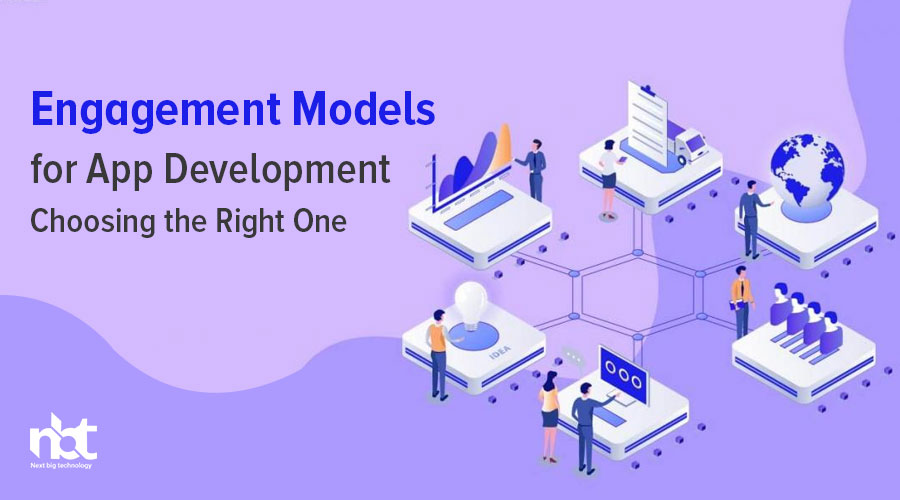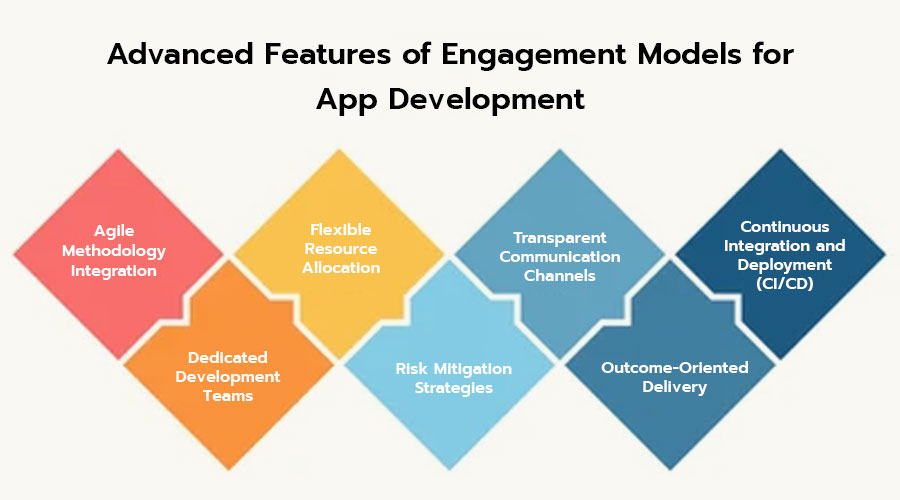Table of Contents
Engagement Models for Apps Services
In today’s digital age, the success of an app service heavily relies on engaging users effectively. From mobile applications to web platforms, choosing the right engagement model is crucial for sustained growth and profitability. With a myriad of options available, businesses must navigate through various strategies to find the perfect fit. Let’s delve into the world of engagement models for app services and uncover the strategies that can elevate your business to new heights.
- Freemium Model: The Freemium model has gained immense popularity in recent years. It offers basic features for free while charging for premium upgrades. This model entices users to explore the app’s functionalities without committing financially upfront. Once users experience the value proposition, they’re more likely to opt for premium features, driving revenue for the business.
- Subscription-Based Model: Subscription-based models offer users access to premium content or features for a recurring fee. This model ensures a steady stream of revenue while fostering a loyal user base. By continuously providing valuable updates and exclusive content, businesses can retain subscribers and maximize lifetime value.
- Pay-Per-Use Model: Pay-per-use models charge users based on their usage of the app’s services or features. This model appeals to users who prefer flexibility and control over their expenses. Businesses can implement tiered pricing structures or offer credits for bulk purchases to incentivize usage and increase revenue.
- Advertising Model: Advertising models monetize app services through targeted advertisements. By leveraging user data and behavior analysis, businesses can deliver personalized ads that resonate with their audience. However, striking a balance between ad revenue and user experience is essential to prevent user churn.
- In-App Purchases Model: In-app purchases allow users to buy virtual goods, upgrades, or additional content within the app. This model capitalizes on impulse buying behavior and enhances user engagement through gamification and incentivized rewards. Businesses must carefully design in-app purchase mechanisms to avoid alienating users with excessive monetization tactics.
- Affiliate Marketing Model: Affiliate marketing models enable businesses to earn commissions by promoting third-party products or services within the app. By partnering with relevant brands and affiliates, businesses can expand their revenue streams while providing added value to users. Transparency and authenticity are key to building trust and credibility in affiliate partnerships.
- Hybrid Model: Hybrid engagement models combine elements of multiple strategies to optimize revenue generation and user engagement. By diversifying monetization channels and tailoring offerings to different user segments, businesses can maximize profitability while accommodating varying user preferences.
Choosing the right engagement model depends on various factors, including the nature of the app, target audience, and industry trends. Conducting thorough market research and analyzing user feedback can provide valuable insights into the most effective approach for your business. Additionally, regularly monitoring key performance indicators (KPIs) and adapting strategies accordingly is essential for long-term success.
How to Create a Engagement Models for App Development
In the rapidly evolving landscape of app development, creating an effective engagement model is crucial for success. An engagement model serves as the blueprint for collaboration between clients and development teams, outlining expectations, responsibilities, and the overall approach to the project. By crafting a well-defined engagement model, both parties can ensure a smooth and productive development process that results in a high-quality app that meets business objectives. Here’s how you can create an engagement model that sets the stage for success:
- Understand the Client’s Needs: The first step in creating an engagement model is to thoroughly understand the client’s requirements, goals, and vision for the app. Schedule meetings or workshops to gather insights directly from the client and key stakeholders. Ask probing questions to uncover their expectations regarding features, functionality, target audience, timeline, and budget constraints.
- Define Project Scope and Objectives: Once you have a clear understanding of the client’s needs, work together to define the project scope and objectives. Outline the features and functionalities that the app will include, as well as any specific deliverables or milestones. Establishing a clear scope upfront helps prevent scope creep and ensures that both parties are aligned on project goals.
- Select an Appropriate Engagement Model: There are several engagement models to choose from, including fixed-price, time and materials, and dedicated team models. Evaluate the pros and cons of each model based on the project requirements, complexity, and level of flexibility needed. For instance, a fixed-price model may be suitable for well-defined projects with clear deliverables, while a time and materials model provides more flexibility for iterative development.
- Outline Roles and Responsibilities: Clearly define the roles and responsibilities of both the client and the development team within the engagement model. This includes identifying key stakeholders, project managers, developers, designers, testers, and any other contributors. Establish communication channels and protocols to ensure effective collaboration and decision-making throughout the project lifecycle.
- Set Communication and Reporting Cadence: Effective communication is essential for successful app development projects. Establish regular communication cadence, including weekly or bi-weekly status meetings, progress reports, and milestone reviews. Define the tools and platforms that will be used for communication, such as email, project management software, or collaboration platforms like Slack or Microsoft Teams.
- Agree on Change Management Process: Changes are inevitable in app development projects, so it’s important to have a robust change management process in place. Define how changes to the project scope, requirements, or timeline will be evaluated, documented, and implemented. Clearly outline the approval process for change requests and any associated impact on budget or timeline.
- Ensure Transparency and Accountability: Transparency and accountability are key principles of effective engagement models. Provide regular updates on project progress, budget utilization, and any issues or risks that may arise. Encourage open and honest communication between all stakeholders, and address any concerns or challenges proactively to avoid delays or misunderstandings.
- Include Provision for Quality Assurance and Testing: Quality assurance and testing are critical components of app development to ensure a seamless user experience and minimize bugs or defects. Define the testing strategy, including the types of testing to be conducted (e.g., functional testing, usability testing, performance testing) and the criteria for acceptance. Allocate sufficient time and resources for testing within the project timeline.
- Establish a Post-launch Support Plan: The engagement model should also include provisions for post-launch support and maintenance. Outline the process for addressing bug fixes, updates, and enhancements following the app’s release. Define service level agreements (SLAs) for response times and resolution of issues, and clarify any ongoing support fees or arrangements.
- Review and Refine Regularly: Finally, remember that the engagement model is not set in stone. It’s important to review and refine the model regularly based on feedback, lessons learned, and evolving project requirements. Solicit input from both the client and the development team to identify areas for improvement and make adjustments as needed to optimize the collaboration.
How to Create a Engagement Models for App Development
In the rapidly evolving landscape of app development, creating an effective engagement model is crucial for success. An engagement model serves as the blueprint for collaboration between clients and development teams, outlining expectations, responsibilities, and the overall approach to the project. By crafting a well-defined engagement model, both parties can ensure a smooth and productive development process that results in a high-quality app that meets business objectives. Here’s how you can create an engagement model that sets the stage for success:
- Understand the Client’s Needs: The first step in creating an engagement model is to thoroughly understand the client’s requirements, goals, and vision for the app. Schedule meetings or workshops to gather insights directly from the client and key stakeholders. Ask probing questions to uncover their expectations regarding features, functionality, target audience, timeline, and budget constraints.
- Define Project Scope and Objectives: Once you have a clear understanding of the client’s needs, work together to define the project scope and objectives. Outline the features and functionalities that the app will include, as well as any specific deliverables or milestones. Establishing a clear scope upfront helps prevent scope creep and ensures that both parties are aligned on project goals.
- Select an Appropriate Engagement Model: There are several engagement models to choose from, including fixed-price, time and materials, and dedicated team models. Evaluate the pros and cons of each model based on the project requirements, complexity, and level of flexibility needed. For instance, a fixed-price model may be suitable for well-defined projects with clear deliverables, while a time and materials model provides more flexibility for iterative development.
- Outline Roles and Responsibilities: Clearly define the roles and responsibilities of both the client and the development team within the engagement model. This includes identifying key stakeholders, project managers, developers, designers, testers, and any other contributors. Establish communication channels and protocols to ensure effective collaboration and decision-making throughout the project lifecycle.
- Set Communication and Reporting Cadence: Effective communication is essential for successful app development projects. Establish regular communication cadence, including weekly or bi-weekly status meetings, progress reports, and milestone reviews. Define the tools and platforms that will be used for communication, such as email, project management software, or collaboration platforms like Slack or Microsoft Teams.
- Agree on Change Management Process: Changes are inevitable in app development projects, so it’s important to have a robust change management process in place. Define how changes to the project scope, requirements, or timeline will be evaluated, documented, and implemented. Clearly outline the approval process for change requests and any associated impact on budget or timeline.
- Ensure Transparency and Accountability: Transparency and accountability are key principles of effective engagement models. Provide regular updates on project progress, budget utilization, and any issues or risks that may arise. Encourage open and honest communication between all stakeholders, and address any concerns or challenges proactively to avoid delays or misunderstandings.
- Include Provision for Quality Assurance and Testing: Quality assurance and testing are critical components of app development to ensure a seamless user experience and minimize bugs or defects. Define the testing strategy, including the types of testing to be conducted (e.g., functional testing, usability testing, performance testing) and the criteria for acceptance. Allocate sufficient time and resources for testing within the project timeline.
- Establish a Post-launch Support Plan: The engagement model should also include provisions for post-launch support and maintenance. Outline the process for addressing bug fixes, updates, and enhancements following the app’s release. Define service level agreements (SLAs) for response times and resolution of issues, and clarify any ongoing support fees or arrangements.
- Review and Refine Regularly: Finally, remember that the engagement model is not set in stone. It’s important to review and refine the model regularly based on feedback, lessons learned, and evolving project requirements. Solicit input from both the client and the development team to identify areas for improvement and make adjustments as needed to optimize the collaboration.
Advantages and Disadvantages of Engagement Models for App Development
In the realm of app development, choosing the right engagement model is crucial for the success of a project. These engagement models dictate how developers and clients interact, collaborate, and manage the development process. Each model comes with its own set of advantages and disadvantages, which must be carefully considered before making a decision. Let’s delve into the various engagement models and explore their pros and cons.
- Fixed Price Model:
Advantages:
- Predictable costs: Clients know the exact cost of the project upfront, making budgeting easier.
- Clear timelines: Fixed deadlines ensure that the project stays on track and is completed within a specified timeframe.
- Low risk for clients: Since the price is agreed upon before the project begins, clients are protected from unexpected costs.
Disadvantages:
- Limited flexibility: Changes to the project scope can be challenging and may incur additional costs.
- Quality concerns: Developers may prioritize meeting deadlines over delivering high-quality work.
- Lack of collaboration: Limited client involvement may lead to misunderstandings or dissatisfaction with the final product.
- Time and Material Model:
Advantages:
- Flexibility: Clients can make changes to the project scope or requirements as needed without incurring significant additional costs.
- Transparency: Clients have full visibility into the development process, including time spent and resources used.
- Focus on quality: Developers prioritize delivering a high-quality product over meeting strict deadlines.
Disadvantages:
- Uncertain costs: Since billing is based on time and resources, the final cost of the project may exceed initial estimates.
- Potential for scope creep: Without clear boundaries, projects may expand beyond the original scope, leading to delays and increased costs.
- Client involvement required: Clients must actively participate in the development process to ensure that the project stays on track.
- Dedicated Team Model:
Advantages:
- Extended team: Clients have access to a dedicated team of developers, designers, and other experts who work exclusively on their project.
- Scalability: The team can be scaled up or down based on project requirements, allowing for greater flexibility.
- Direct communication: Clients have direct communication with team members, fostering collaboration and ensuring that their vision is accurately realized.
Disadvantages:
- Higher costs: The dedicated team model can be more expensive than other engagement models, particularly for smaller projects.
- Management overhead: Clients may need to invest time and resources into managing the dedicated team, including task assignment and coordination.
- Dependency on team members: If key team members leave or are unavailable, it may disrupt the development process and lead to delays.
| Engagement Model | Advantages | Disadvantages |
|---|---|---|
| Fixed Price | – Clear budgetary expectations | – Limited flexibility for changes during development |
| – Defined project scope and timelines | – Risk of underestimating project complexities | |
| – Minimal financial risk for the client | – Scope creep may lead to additional costs | |
| Time and Material | – Flexibility to accommodate changes | – Uncertain project costs and timelines |
| – Agile approach allows for iterative development | – Requires active project management | |
| – Suitable for long-term or evolving projects | – Cost overruns if not managed effectively | |
| Dedicated Team | – Dedicated resources focused on the project | – Higher upfront costs compared to other models |
| – Enhanced control over project development | – Dependency on team availability and expertise | |
| – Scalability to adapt to project requirements | – Management overhead for client organization | |
| – Long-term collaboration fosters team synergy | – Potential communication gaps in distributed teams |
Benefits of Engagement Models for App Development

In today’s rapidly evolving digital landscape, the demand for mobile applications continues to surge. Whether it’s for business, entertainment, or productivity, mobile apps have become an integral part of our daily lives. However, developing a successful app requires more than just coding skills. It demands a comprehensive understanding of the project’s requirements, effective communication, and a streamlined development process. This is where engagement models for app development come into play, offering a range of benefits that can propel your project towards success.
1. Tailored Solutions: Engagement models allow for the customization of development processes based on the unique needs of each project. Whether it’s a small startup venture or a large enterprise application, the engagement model can be tailored to suit the specific requirements, ensuring that resources are allocated efficiently and effectively.
2. Flexibility and Scalability: One of the key advantages of engagement models is their flexibility. They provide the flexibility to scale resources up or down based on project requirements. Whether you need to ramp up development during peak periods or scale back during slower phases, the engagement model allows for seamless adjustments, ensuring optimal resource utilization at all times.
3. Cost-Effectiveness: Engagement models offer cost-effective solutions by providing transparent pricing structures and eliminating unnecessary overheads. Whether you opt for a fixed-price model, time and material model, or dedicated team model, you have full control over your budget and expenditure. This ensures that you only pay for the services you require, without any hidden costs or surprises along the way.
4. Enhanced Collaboration: Effective communication and collaboration are essential for the success of any app development project. Engagement models facilitate regular communication between the development team and the client, ensuring that everyone is on the same page throughout the project lifecycle. This fosters a collaborative working environment where ideas can be shared, feedback can be provided, and challenges can be addressed in a timely manner.
5. Risk Mitigation: Engagement models help mitigate risks by providing clear milestones, timelines, and deliverables. By breaking down the project into manageable stages, risks can be identified and addressed early on, minimizing the chances of costly delays or setbacks. Additionally, regular progress updates and feedback sessions ensure that any issues are resolved promptly, keeping the project on track towards successful completion.
6. Focus on Core Competencies: Outsourcing app development through engagement models allows businesses to focus on their core competencies while leaving the technical aspects to the experts. This enables companies to allocate their resources more efficiently, focusing on strategic initiatives that drive growth and innovation, while leaving the development process in capable hands.
Advanced Features of Engagement Models for App Development
In the dynamic realm of app development, choosing the right engagement model is crucial for ensuring project success. As businesses seek more flexibility, scalability, and efficiency in their app development processes, advanced engagement models have emerged to cater to diverse needs. Let’s delve into some of these advanced features that offer unique advantages for app development endeavors.
- Agile Methodology Integration: Agile methodologies have revolutionized the software development landscape by emphasizing iterative development, collaboration, and adaptability. Advanced engagement models seamlessly integrate Agile practices, allowing for quick iterations, continuous feedback, and better alignment with evolving business goals. This approach fosters transparency, enhances project visibility, and accelerates time-to-market, ensuring that apps meet evolving user demands effectively.
- Dedicated Development Teams: In complex app development projects, having a dedicated team of skilled professionals can make a significant difference. Advanced engagement models offer the option to establish dedicated development teams exclusively focused on a single project. This fosters deeper domain expertise, stronger team cohesion, and streamlined communication, leading to superior project outcomes and enhanced product quality.
- Flexible Resource Allocation: Traditional engagement models often lack the flexibility needed to adapt to changing project requirements and resource demands. Advanced models, such as the Time and Material (T&M) or Dedicated Team model, provide greater flexibility in resource allocation. Clients can scale up or down their development team size based on project needs, ensuring optimal resource utilization and cost-effectiveness throughout the app development lifecycle.
- Risk Mitigation Strategies: Mitigating risks is paramount in app development, where uncertainties and challenges abound. Advanced engagement models incorporate robust risk mitigation strategies to proactively identify, assess, and address potential risks throughout the project lifecycle. From contingency planning to risk monitoring and mitigation frameworks, these models empower businesses to navigate uncertainties effectively and safeguard project success.
- Transparent Communication Channels: Effective communication is the cornerstone of successful app development projects. Advanced engagement models prioritize transparent communication channels, enabling seamless collaboration between clients, development teams, and stakeholders. Leveraging modern communication tools and methodologies, such as Slack channels, regular status meetings, and real-time reporting dashboards, ensures that everyone remains aligned, informed, and engaged throughout the development journey.
- Outcome-Oriented Delivery: Unlike traditional engagement models focused solely on deliverables, advanced models prioritize outcome-oriented delivery. This means shifting the focus from merely completing tasks to delivering tangible business value and measurable outcomes. By aligning development efforts with overarching business objectives and user needs, these models ensure that apps not only meet technical specifications but also drive meaningful impact and achieve desired business outcomes.
- Continuous Integration and Deployment (CI/CD): To keep pace with rapid market changes and user expectations, advanced engagement models embrace CI/CD practices. Continuous Integration (CI) and Continuous Deployment (CD) streamline the development, testing, and deployment processes, enabling faster and more reliable delivery of app updates and enhancements. By automating build, test, and deployment pipelines, these models enhance efficiency, reduce time-to-market, and ensure a seamless user experience.
How Do Engagement Models for App Work?
In the fast-paced world of mobile applications, creating engaging experiences for users is crucial for success. This is where understanding and implementing effective engagement models become paramount. From freemium to subscription-based models, each approach offers its own set of benefits and challenges. So, let’s delve into how these engagement models work and why they are essential for app developers and businesses alike.
What are Engagement Models?
Engagement models refer to the strategies employed by app developers to attract users and keep them actively using their application. These models dictate how users interact with the app and how developers monetize their efforts. Essentially, they are the backbone of the app’s revenue generation and sustainability.
Freemium Model:
The freemium model is one of the most popular engagement models in the app industry. It offers users free access to the basic features of the app while charging for premium features or content. This approach allows developers to attract a large user base initially without imposing any upfront costs. Once users are hooked and see the value in the premium features, they are more likely to upgrade to a paid version or make in-app purchases.
Subscription-Based Model:
In the subscription-based model, users pay a recurring fee at regular intervals (monthly, quarterly, or annually) to access the app’s features or content. This model is common among content streaming services, productivity apps, and software-as-a-service (SaaS) platforms. By offering a continuous stream of updates, new content, and exclusive features, developers can ensure a steady revenue stream while providing ongoing value to subscribers.
Pay-Per-Use Model:
Unlike the freemium and subscription-based models, the pay-per-use model charges users each time they utilize a specific feature or service within the app. This approach is prevalent in gaming apps, where users purchase in-game currency, lives, or power-ups as they progress through the game. While this model can generate significant revenue from a small subset of dedicated users, it may deter casual users who are hesitant to make frequent purchases.
Ad-Supported Model:
The ad-supported model relies on displaying advertisements within the app to generate revenue. Developers can choose from various ad formats, such as banners, interstitials, rewarded videos, and native ads, to monetize their app effectively. By leveraging user data and targeted advertising, developers can maximize ad revenue while ensuring a seamless user experience. However, excessive or intrusive ads can drive users away, so finding the right balance is crucial.
Why Engagement Models Matter:
Effective engagement models are essential for app developers and businesses for several reasons:
- Revenue Generation: Engagement models directly impact revenue generation by determining how users pay for the app’s features or content.
- User Retention: Engaging users through value-added features and incentives increases user retention rates and fosters long-term relationships with the app.
- Competitive Edge: By implementing innovative engagement models, developers can differentiate their app from competitors and attract a loyal user base.
- Monetization Flexibility: Different engagement models offer flexibility in monetization, allowing developers to adapt to changing market trends and user preferences.
- Sustainability: Sustainable revenue streams ensure the long-term viability of the app and enable continuous improvements and updates.
Top Engagement Models for App Development Companies
In the fast-paced world of app development, engaging clients effectively is paramount to success. App development companies rely on robust engagement models to ensure client satisfaction, project efficiency, and business growth. From traditional approaches to innovative methodologies, there are several engagement models tailored to meet diverse client needs. Let’s delve into some of the top engagement models for app development companies.
-
-
Next Big Technology:

Focus Area
- Mobile App Development
- App Designing (UI/UX)
- Software Development
- Web Development
- AR & VR Development
- Big Data & BI
- Cloud Computing Services
- DevOps
- E-commerce Development
Industries Focus
- Art, Entertainment & Music
- Business Services
- Consumer Products
- Designing
- Education
- Financial & Payments
- Gaming
- Government
- Healthcare & Medical
- Hospitality
- Information Technology
- Legal & Compliance
- Manufacturing
- Media
-
- Time and Material Model: In this model, clients pay based on the time and resources expended on the project. It offers flexibility, allowing clients to accommodate changes during development seamlessly. App development companies charge hourly rates for resources utilized, providing detailed timesheets for transparency. While it offers adaptability, clients need to closely monitor project progress to avoid exceeding budgets.
- Dedicated Development Team Model: Ideal for long-term projects, this model involves hiring a dedicated team of developers, designers, and project managers exclusively for the client’s project. App development companies assemble a team tailored to the project’s requirements, ensuring continuity and expertise throughout the development cycle. Clients have full control over the team and project direction, fostering collaboration and innovation.
- Revenue Share Model: In this mutually beneficial model, app development companies receive a share of the revenue generated by the developed app. It aligns the interests of both parties, as the success of the app directly impacts the earnings. App development companies may offer reduced upfront costs or even develop the app at no initial charge in exchange for a percentage of future profits. However, determining equitable revenue shares and managing revenue distribution requires careful negotiation and planning.
- Hybrid Model: Combining aspects of various engagement models, the hybrid model offers a tailored approach to suit specific project requirements. App development companies collaborate with clients to design a hybrid engagement model that combines fixed-price elements for certain project phases with time and material billing for others. It provides flexibility while maintaining cost control and project stability.
- Outcome-Based Model: This results-driven model focuses on delivering predefined outcomes or milestones rather than hours worked or resources utilized. App development companies and clients agree on measurable objectives, such as user acquisition targets or feature delivery timelines. Payments are tied to the achievement of these outcomes, incentivizing app development companies to prioritize efficiency and quality.
FAQs on Engagement Models for App Development
In the ever-evolving landscape of app development, selecting the right engagement model is crucial. Whether you’re a startup or an established enterprise, understanding the various engagement models can streamline the development process, manage costs effectively, and ensure project success. Here are some frequently asked questions (FAQs) to guide you through the maze of engagement models:
- What are engagement models in app development? Engagement models define the relationship between a client and a development team. They outline how tasks will be delegated, communication channels, project timelines, and cost structures.
- What are the common types of engagement models? The most common engagement models include Fixed Price, Time and Materials (T&M), Dedicated Team, and Agile. Each model offers distinct advantages and is suitable for different project requirements.
- What is a Fixed Price engagement model? In a Fixed Price model, the project scope, timeline, and cost are predetermined. It works best for well-defined projects with minimal expected changes.
- When should I opt for a Time and Materials (T&M) model? T&M model is ideal for projects with evolving requirements. It offers flexibility, allowing clients to make changes during the development process. Billing is based on the actual time and resources spent.
- What is a Dedicated Team model? In a Dedicated Team model, the development team works exclusively on the client’s project. The client pays a monthly fee for the team’s services, providing scalability and control over resources.
- How does Agile engagement model differ from others? Agile is a flexible and iterative approach to development. It emphasizes collaboration, adaptive planning, and continuous improvement. Agile teams work in sprints, delivering working software incrementally.
- Which engagement model is suitable for startups? Startups often benefit from Agile or Dedicated Team models as they provide flexibility and adaptability to changing market demands. These models allow startups to scale their development efforts according to their growth trajectory.
- How do I choose the right engagement model for my project? The choice of engagement model depends on factors such as project scope, budget, timeline, and flexibility requirements. Assess your project needs carefully and consult with your development partner to determine the most suitable model.
- Can I switch between engagement models during the project lifecycle? While it’s possible to transition between engagement models, it’s essential to consider the implications on project timelines, costs, and team dynamics. Communicate effectively with your development team to ensure a smooth transition if needed.
- What factors should I consider when negotiating terms in an engagement model? When negotiating terms, consider aspects such as payment schedules, change management procedures, communication protocols, and intellectual property rights. Clarify expectations upfront to avoid misunderstandings later.
Thanks for reading our post “Engagement Models for App Development: Choosing the Right One”. Please connect with us to learn more about Engagement Models for App.














